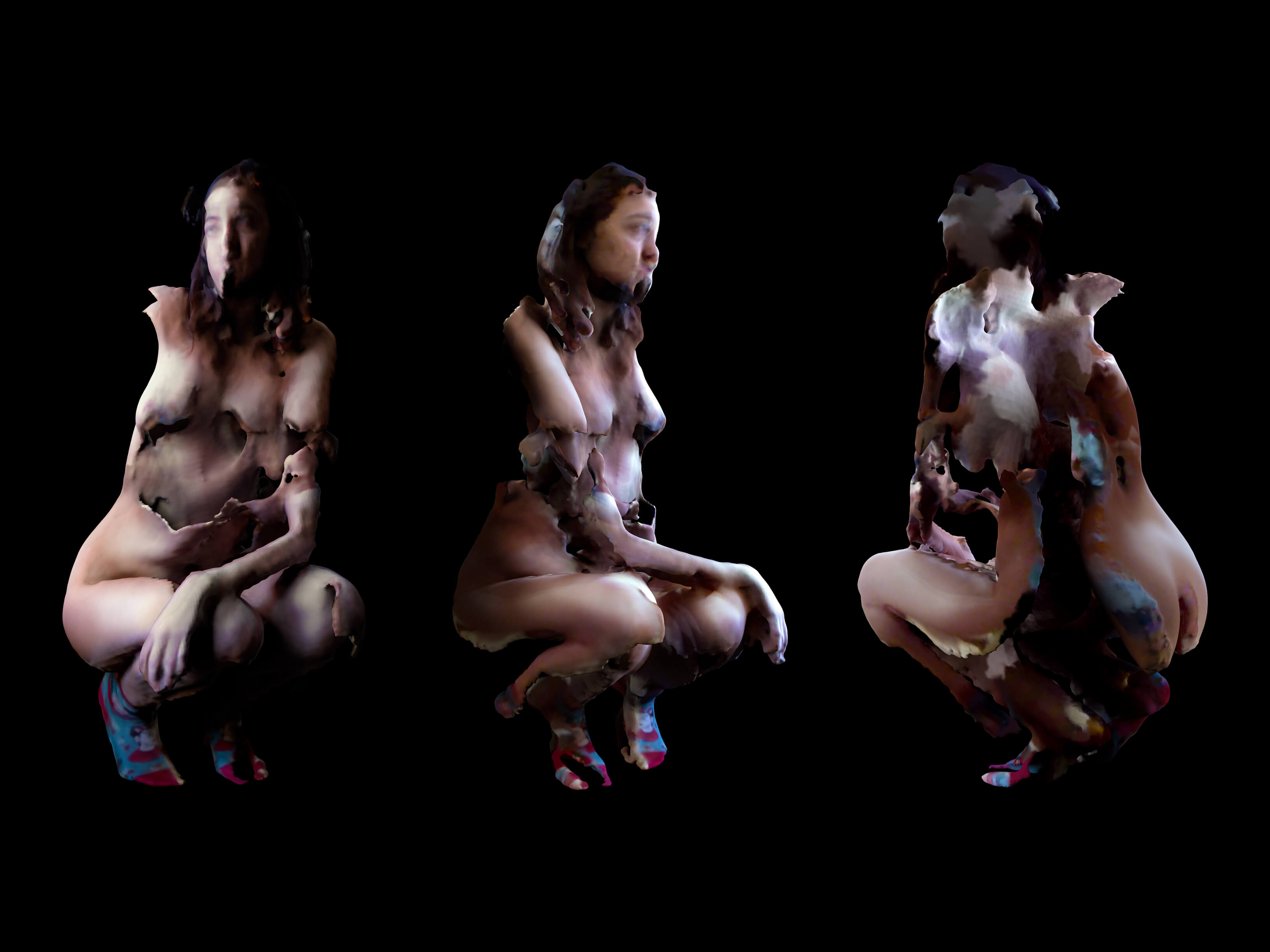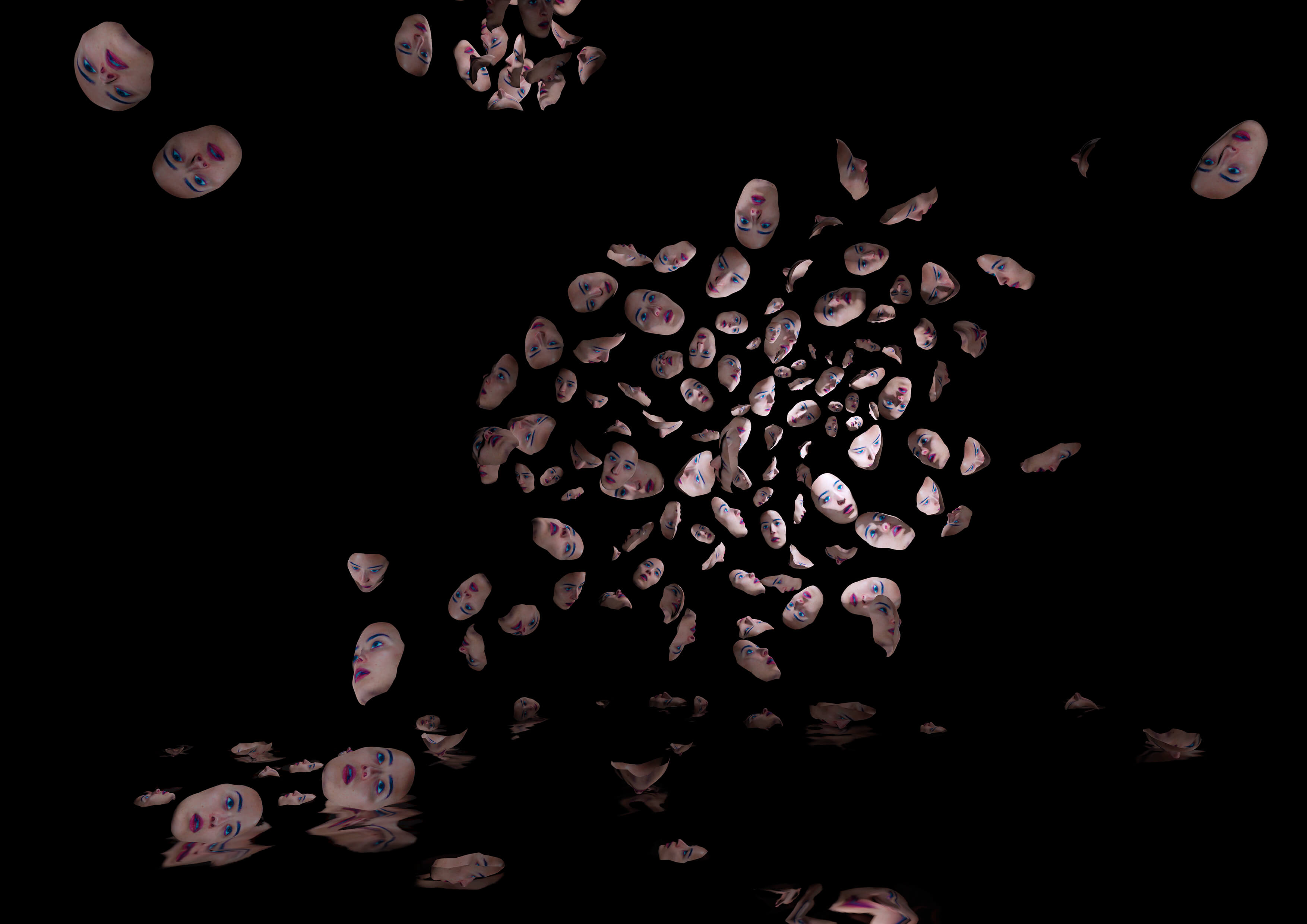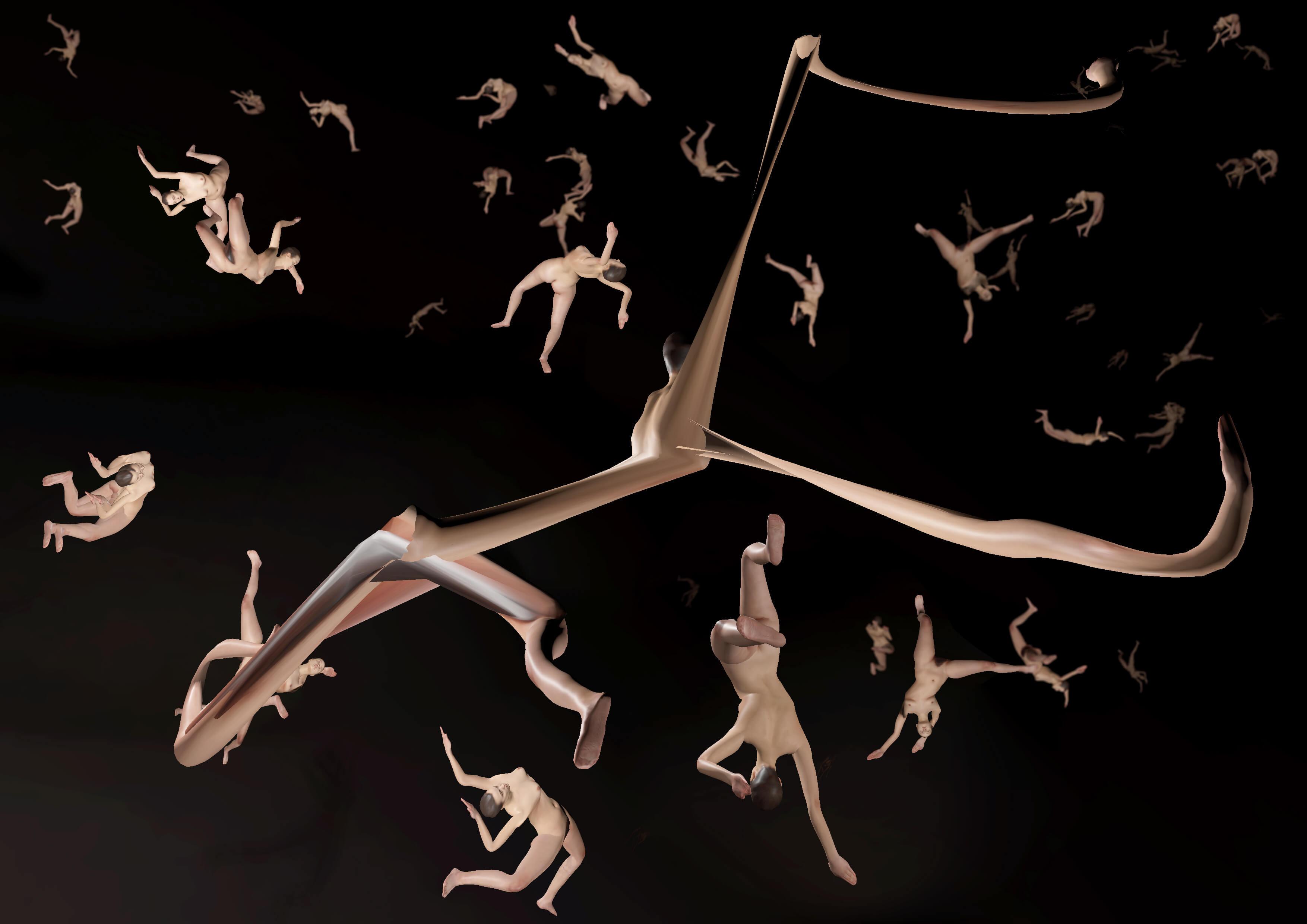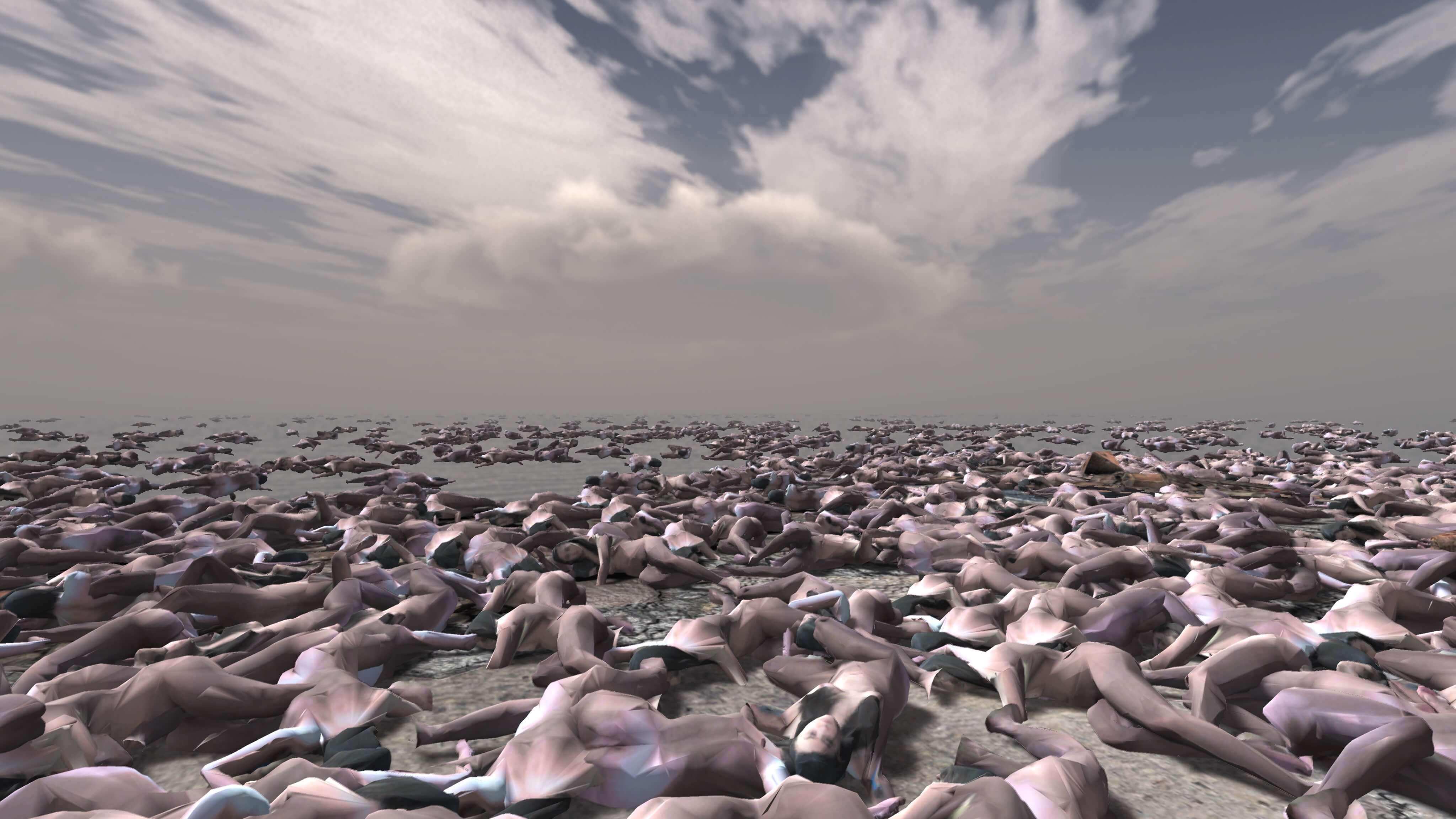




Martina Menegon: Synthetic Corporeality
Martina Menegon's work emanates from her urge to work with the concept of avatars and digital selves. With her 3D scanned bodies and faces that often appear distorted and glitched, the artist works against the concept of the beautiful and perfect self-image as exemplified on social media. Her work can be understood as a counter image to the beauty craze exacerbated by digital enhancement. Instead, the static appearance of Menegon’s face masks rather refers to antique theater masks behind which the actor entirely disappears. It signifies absence instead of conveying personal information. When working with her digital body, the artist also excludes any social context (conveyed by clothing) and only appears nude. User interaction is a key element in Menegon’s work and oftentimes the user shapes the appearance of the artist’s body. Martina Menegon explores the different ways in which human bodies behave under digital conditions. The artist understands her practice as an exploration of synthetic corporeality, which she describes as a form of virtual reality that can be physically perceived. Her own body becomes the interface between both realities and a tool for the exploration of the conditions, limitations, and possibilities of the digital realm.
Biography
Martina Menegon (*Italy, 1988) is an artist based in Vienna working predominantly with Interactive and Extended Reality Art. In her works, she creates intimate and complex assemblages of physical and virtual elements that explore the contemporary self and its phygital corporeality. She experiments with the uncanny and the grotesque, the self and the body and the dialogue between physical and virtual realities, to create disorienting experiences that become perceivable despite their virtual nature. Since 2011 Martina Menegon has been teaching in various festivals, institutions and universities, including the Art University in Linz, Austria (“Introduction to Interactive Arts” - BA Interactive Art) and the IUAV University in Venice (”multimedia tools for interactive arts” - MA Digital Exhibit, BA Multimedia Arts together with Klaus Obermaier and Stefano D’Alessio). She is currently Senior Artist and Lecturer at the department of Transmedia Art at the University of Applied Arts in Vienna, where she teaches “Digital Design and Virtuality”. In 2019, Martina Menegon founded and co-directed :afk together with Shahab Nedaei. They curated a series of pop-up solo exhibitions at various locations in Vienna focused on Digital, Extended and Virtual Reality Art. Since 2020, Menegon has been Vice Director and Curator at the CIVA Festival for New Media Art as well as Head of Extended Reality and Curator at the platform for immersive experiences “Area for Virtual Art“ on behalf of sound:frame. Martina Menegon’’s work has been exhibited internationally online and AFK, in festival, galleries and institutions such as MAK Museum of Applied Arts Vienna, NRW-Forum Düsseldorf, Roehrs & Boetsch Gallery, Les Rencontres d’Arles, WRO Biennale, HeK - House of Electronic Arts.
Interview with Martina Menegon (Vienna)
by Tina Sauerlaender (Berlin), April 17, 2020
Tina Sauerlaender: Hello Martina! What was the initial motivation to work with self-representation?
Martina Menegon: The main urge was to work with the concept of avatars and our digital selves. I was a bit tired of using these 3D models of humans I could find online, I wanted to have my own body, so I started to find ways with my low budget to digitalize myself, to work with my own body. And I started it because I had these tools at home that allowed me to do that.
TS: Virtual Narcissism (2016) is the first work where you used these digitalized avatars of yours. Could you elaborate on the concept?
MM: The whole idea of Virtual Narcissism was: “How is a 3D model different from a selfie?” Usually, I would take the phone and take a photo of me, but with the 3D scan it is a totally different process. I scan myself and the output is the technical result of me trying to digitalize my own self. I always end up with distortion because I cannot sit super still, and I don't have the technical equipment for doing a perfect scan. These distorted bodies that came out were unexpected for me.
TS: Virtual Narcissism happened in a time where selfies have been considered as narcissistic. Did this influence your work?
Martina Menegon: I was really getting sick of this narcissist being of trying to find the perfection, to have a perfect image of yourself and long for perfection. Virtual Narcissism happened at a time where I needed to go against perfection that was kind of all over social media. I had this inner urge of working with distortion. All my works in the end try to achieve something through the digital self, but never arriving at perfection, actually going against it.
TS: And then you created the VR artwork Plug Your Nose And Try To Hum (2017). There, we see a perfectly scanned 3D avatar of yours, and not the distorted one from Virtual Narcissism. Why?
MM: I was wondering “How can I reach the perfect digital self in the virtual?” So I went to a 3D studio to have myself scanned professionally. When I got the results, I was like "Oh my god, this is so perfect, there are so many details. When I put this object in the virtual space it was super tiny and I was like "this looks so fragile." My perfect body in this tiny size did something to me and I just wanted to keep working on rescaling myself. What is very interesting for me is that you have the possibility to stretch and throw it and even be very aggressive to these fragile creatures, but you could also be very gentle. It's quite interesting to see how people get super crazy with the bodies in the end.
TS: Where does your fascination with digital avatars come from?
MM: Doing the work I do, people think that I must be super okay with how my body looks. But for me it's exactly the opposite, I am extremely not okay with it. You know I have curly hair, but I don't see myself with curls. When I experienced Second Life, I could have blonde, matte, red hair, straight, short, changing up anytime I want to. With one click I would be something different and I wish I could do the same with my physical self. So for me, these avatars I use are a bit like dolls. My work is like an escapism from physical reality.
TS: Why did you start working with your naked body?
MM: The reason why I started with the naked body was when I was reading and researching about avatars. The default image when you create an avatar in a software like MakeHuman is going to be naked. And I think the reason behind this is that it is stripped of any relation or any other situation. When I am naked, it is just the naked body. If I would wear a dress, I would add a certain meaning to that body. So, what I want is just to have the body and the meaning around the body.
TS: In All Around Me Are Familiar Faces (2018), your face is turned into a mask-like multiple object. How would you define a mask?
MM: For me a mask is something that you use to hide something behind and to conceal expressions. With my face in All Around Me Are Familiar Faces, I was trying to go against selfie filters, in the sense that face filters usually are made to enhance your face, but my filter is completely hiding your face. You are not smiling, you are not talking, you are not crying, you are not moving. There is no expression because you have this block, this wall in front of your face.
TS: User interaction is very important for your artworks. How does it differ from work to work?
MM: I come from an interactive art background, so Virtual Reality brings my two passions together, my 3D passion with my interactive art passion. The three projects have completely different interactions. Virtual Narcissism is on an iPad and you zoom in and rotate. The reason behind it is that the body can become something different, something abstract, not only through the digitalization but also through the interaction. You see the body rotating in its fullness, but then you could zoom in it so much that it becomes an abstract shape. In All Around Me Are Familiar Faces you have a surrounding that you cannot interact with, the surrounding interacts with you. You have this cloud of faces constantly trying to come to you. And as the user, you can draw a kind of sculpture out of the faces. Also here, the 3D scan becomes something abstract, from body to abstraction. In Plug Your Nose And Try To Hum the interaction is more open in the sense that you could also do nothing and just look at these tiny bodies floating around you. But you can decide to grab them, push or stretch them, or you can throw them. You can choose your level of interaction with those bodies.